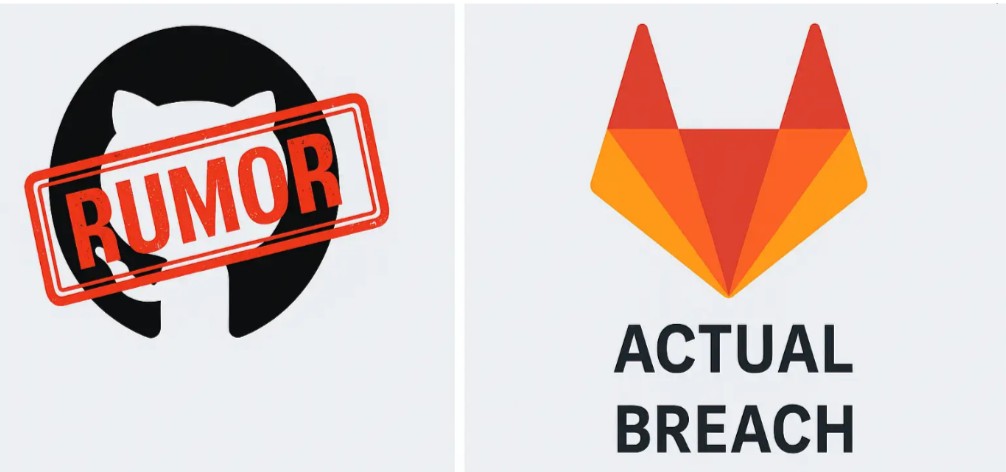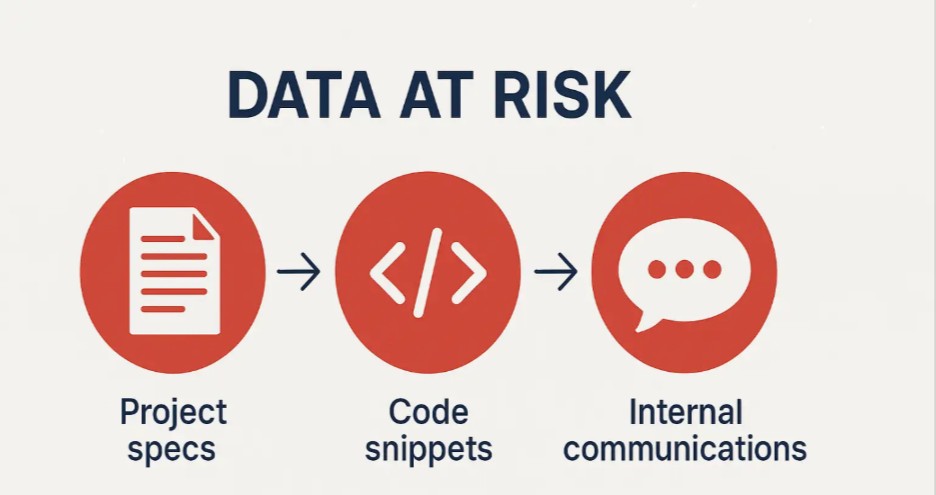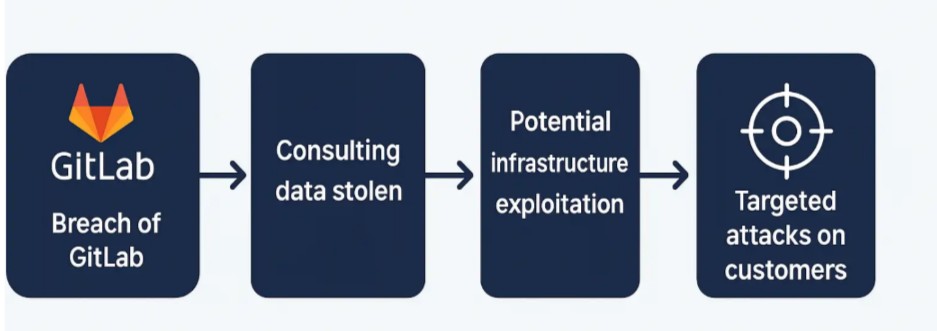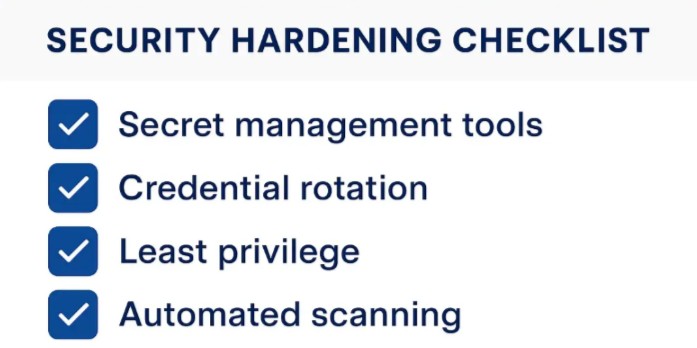Red Hat Consulting GitLab Breach by Cybercrime Group 'Crimson Collective'

Hoplon InfoSec
02 Oct, 2025
In early October 2025, Red Hat found a security hole that made a lot of noise in the cybersecurity world. For a few days, there were many rumors on Telegram channels, online forums, and blogs about a big "Red Hat GitHub breach." The hackers known as the Crimson Collective said they had stolen about 28,000 repositories, which held more than half a terabyte of data. They said they took things like private business papers, Customer Engagement Reports (CERs), infrastructure diagrams, and even tokens that let them log in.
The issue was that this story wasn't entirely true. Red Hat has stressed that the security problem was not a GitHub breach. Red Hat Consulting only used the hacked GitLab instance for a few customer projects. This difference makes the event much smaller, but it also raises important questions about how safe repositories are, how accurate consultancy data is, and how false information can spread when attackers are in charge of the story.
The rumor is going around.

The initial claims made by the Crimson Collective aimed to instill fear in the public. By calling the problem a "GitHub hack," the attackers made it seem like Red Hat's main product repositories and even Microsoft's GitHub infrastructure had been affected. They put out pictures of directory structures, file listings with client names, and samples that they said showed project data. People quickly shared these on social media, making it seem like a big problem had happened that affected Red Hat's software supply chain.
This kind of framing plays on a big fear in the computer world: that hackers could break into the repositories that support open-source projects on a large scale. In an environment that values trust and honesty, even a hint of a significant breach can damage reputations before the facts become clear.
Red Hat's Official Statement on the Breach
On October 2, 2025, Red Hat made a public announcement that said, "Security update: Incident related to Red Hat Consulting GitLab instance." The company said that an unauthorized person accessed its consulting division's GitLab environment. There was a breach, and the intruder's access was cut off. The system that was damaged was also cut off from the rest of the network. Red Hat said that it has worked with the police and added extra security measures to make sure the situation doesn't happen again.
The company did the most important thing by making the scope clear. The hack only affected information about consulting work; it did not affect Red Hat's main products, official software distribution channels, or the supply chain as a whole. Red Hat said that the hacked files could have project specifications, example code snippets, and internal conversations about consulting. They haven't found any private information about people yet, though. Red Hat is contacting customers who hire consultants directly, so they might be affected. There is no evidence of harm to other customers.
GitHub vs. GitLab: The Wrong Way to Tell About the Breach
The platform itself caused a lot of the confusion. Red Hat claimed that the hacked system was GitLab, but the Crimson Collective insisted on referring to it as GitHub instead. This is a giant error. If there is a breach, the two platforms have different jobs and very different outcomes.
Ownership
GitHub: Owned by Microsoft
GitLab (Red Hat Consulting): Self-hosted by organizations
Usage
GitHub: Hosts open-source and enterprise repositories worldwide
GitLab (Red Hat Consulting): Used for internal consulting collaboration at Red Hat
Implication of Breach
GitHub: suggests a widespread compromise of Red Hat products or the global GitHub ecosystem.
GitLab (Red Hat Consulting): Limits scope to consulting project artifacts only.
At first, stories mixed up GitHub and GitLab, which made it seem like someone had stolen Red Hat's main engineering repositories. This was much worse than what Red Hat said. This incident shows how important it is to use the right words when talking about problems with repositories.
What the breach could have shown

Red Hat has said that the hacked environment has artifacts related to consulting, even though the investigation is still going on. These are things like project requirements, example code, and messages about some consulting jobs. Attackers can still use these files, even though they aren't the same as the source code for private products.
Project specifications, for instance, could reveal the configuration of a customer's network. Hackers could use an example code to learn how to change the way they use settings or shortcuts. We could learn about problems, planned changes, or possible problems with the system through internal talks. Even if it doesn't have any personal information in it, this kind of content can still help enemies find their way.
The Attackers' Story of the Breach
The Crimson Collective said they learned a lot more than what Red Hat had told them. Their articles made it seem like they could get to Customer Engagement Reports that had deployment scripts, authentication information, and network diagrams. They also said that Red Hat didn't pay attention to early attempts at responsible disclosure, which is why they had to go public.
There is no evidence yet that these claims are true. You can make up screenshots and file lists, so you can't be certain they're right until someone else says they are. The numbers given, such as 28,000 repositories, don't seem to agree with what Red Hat has said. When someone attacks a computer, they often say something different than what the government says. Attackers lie about what they did to scare people, hurt their reputation, or get more money by threatening to tell others what they did.
Customers are in danger because of the breach.

Even though things aren't as bad as they were, clients of Red Hat Consulting should still be careful. Attackers might be able to launch targeted attacks that take advantage of known weaknesses if they could obtain their hands on infrastructure schematics or configuration notes. Attackers might try to use any login information that was saved in consulting materials again in real systems.
The larger concern lies in the public's access to the supply chain. When you do consulting work, you often have to connect to platforms that aren't yours. The details of those links can endanger not only the customer but also other stakeholders. Red Hat hasn't said for sure that this leak happened, but these examples show why artifacts used for consulting need to be protected as well as core code repositories.
Why Repository Breaches Are So Bad
This event shows that repositories can be helpful in ways that aren't always obvious. Many developers and consultants think that private repositories are safe places because they think that being less visible means being less dangerous. But repositories usually have more than just codes in them. They come with scripts for deployment, templates for infrastructure-as-code, and extra credentials that make things easier.

Attackers are aware of this, and they are now more likely to go after private repositories for operational secrets than for intellectual property. Unnoticed, a single token can grant access to any part of a network. Consulting projects are riskier because repositories may have snapshots of customer environments, which could make the damage even worse.
What We Learned from the Breach
The hack of GitLab at Red Hat Consulting shows how important it is to have strict rules for repository security. Code repositories should never have private information in them. Instead, businesses should use separate secret management systems, change their passwords often, and give all accounts and tokens only the access they need.
Automation can also be useful. Tools that search for secrets prior to commits and systems that detect unusual behavior enhance security further. People will make mistakes, but having more than one layer of protection can help keep the damage to a minimum.
Problems with talking to one another
Another lesson is how important it is to talk to each other when something goes wrong. The attackers were the first to share their perspective, and they did so in the most detrimental manner possible. The idea of a GitHub breach had already spread around the world by the time Red Hat made things clear.
This incident shows how hard it is to find the right balance. If businesses talk too fast, they could make things worse. They could hurt their reputation if they wait too long. The Red Hat incident shows that hackers will make up their own stories to fill in the gaps. Companies must plan how to fix technical issues and communicate with people to maintain trust.
Broader Effects on the Supply Chain
This break may not seem like much, but it has big consequences. These days, supply chains do more than just send out software. They also provide integration, maintenance, and consulting services. Engagement artifacts like project specs and deployment instructions could be used to start attacks if they aren't kept safe.
Companies should know that checking the main products of their providers is not enough to keep their digital ecosystems safe. They also need to know how to handle data from consultants. The Red Hat leak shows that code used for consulting can be just as secret as code used for production.
What Is Still Not Known
There are still some important things that aren't clear. We don't know how the breach happened, so we don't know if it was because someone stole credentials, there was a flaw, or an insider used their access inappropriately. Red Hat hasn't said for sure that the hacked files did have the most sensitive information that the hackers said they did, like CERs.
There will be rumors until we learn more. When customers and partners don't have all the facts, they tend to think the worst, which is bad in and of itself.
Help for Customers
People who work with Red Hat Consulting should see the breach as a sign to be careful. It's a good idea to change any passwords that were shared during meetings, check authentication logs, and keep a closer eye on systems that are linked to consulting projects. Red Hat says that there is no proof that the situation has had an effect on its products or supply chain, so there is no need to do anything right now.
But the most important thing to remember is that you should never think that consulting repositories isn't worth much. Attackers know how important they are, so businesses need to protect them.
Final Thoughts
The Red Hat Consulting GitLab hack shows how dangerous it is to have your repository hacked and how bad it is to spread false information. Attackers tried to make the event sound like a terrible GitHub hack, but Red Hat's statement made it seem a lot less serious. But there are worries that can't be ignored when engagement data is shared with the public.
Red Hat's next step is to reassure its consulting clients, be open and honest, and make sure that this doesn't happen again. The breach is a big warning to everyone in the business that important information can be accessed from any repository, like GitHub, GitLab, or any other, if it isn't well protected.
As digital ecosystems become more connected, trust will depend on more than just keeping important things safe. It will also depend on keeping every piece of engagement data, collaborative space, and consulting repository safe. The Red Hat Consulting GitLab hack shows that hackers will go after the easiest target. This means that companies need to be ready to protect everyone.
Hoplon Insight Box: Recommendations
· Revoke and rotate tokens to block stolen credentials
· Audit repositories for secrets and weak points
· Notify customers quickly to build trust.
· Use secret management tools instead of code storage
· Limit token privileges to minimize exposure.
· Enable monitoring alerts for unusual activity
· Review supply chain links for hidden risks
· Stay transparent to restore community confidence
Hoplon Infosec’s Deep and Dark Web Monitoring detects stolen credentials, exposed repos, and leaked data fast, helping organizations act quickly to secure sensitive information and prevent further risks.
Follow us on X (Twitter) and LinkedIn for more cybersecurity news and updates. Stay connected on YouTube, Facebook, and Instagram as well. At Hoplon Infosec, we’re committed to securing your digital world.
Share this :